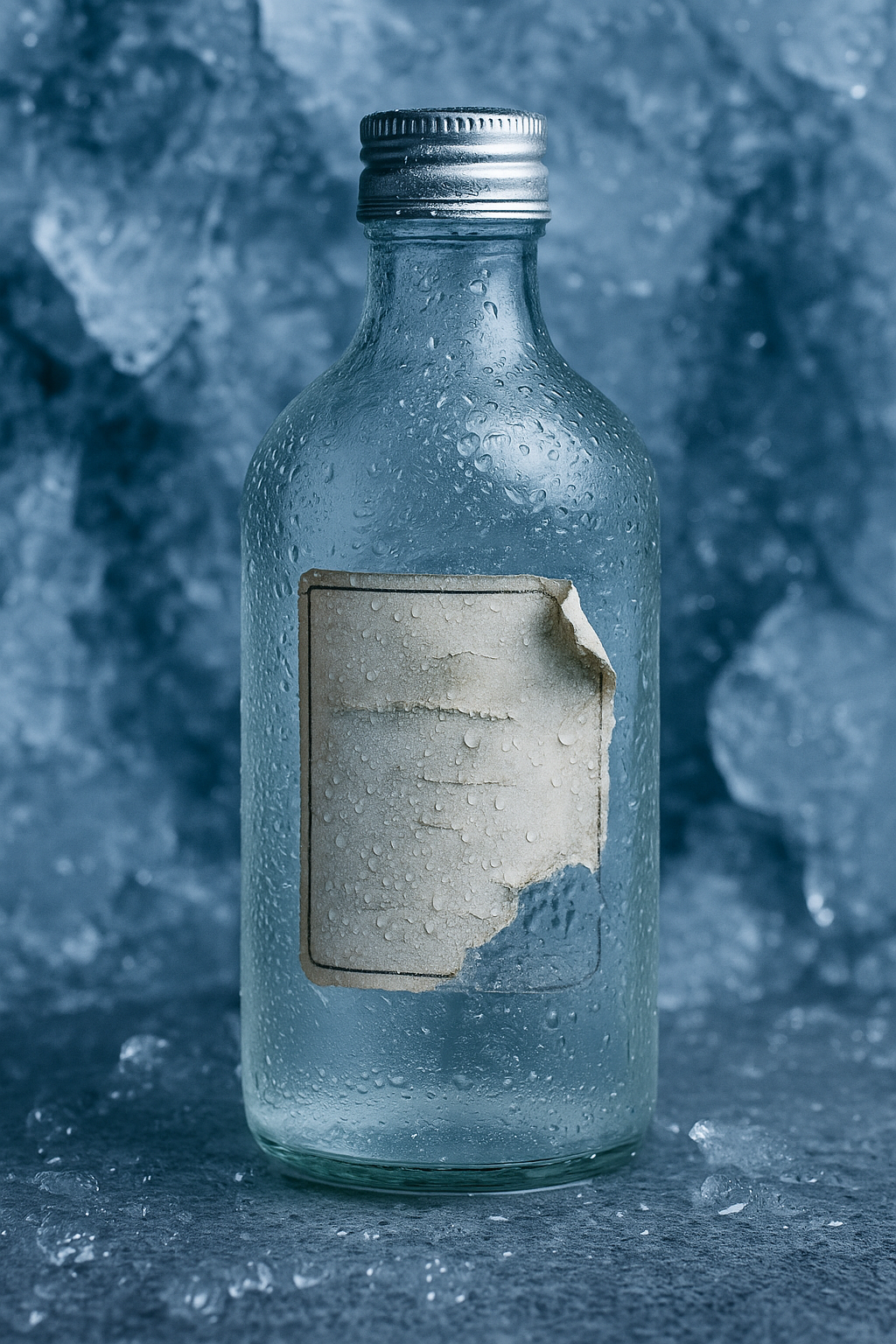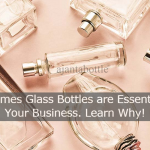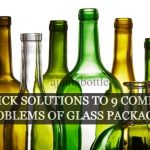A decorated glass bottle doesn’t speak, yet it tells a story.
Before a word is read, before a product is tasted, touched, or trusted, it is the bottle that speaks first. The shimmer of a foil crest, the elegance of a frosted surface, the subtle depth of a matte finish – these are not mere embellishments. They are brand promises, carefully curated and etched into form.
But what happens when that beautiful promise, crafted in the comfort of a controlled design studio, is sent into the unpredictable world?
What happens when it is packed into a truck that reaches 42 degrees Celsius on its way to rural Maharashtra?
What happens when it sits in a warehouse in Kochi through weeks of 90 percent humidity?
What happens when it is jostled against cardboard dividers inside an e-commerce box?
What happens when it arrives scratched, faded, and far from the brilliance it once held?
The truth is simple. Decoration is not just about how it looks. It is about how long it lasts.
And in 2025, where premium FMCG growth, global shipping routes, and climate volatility are rewriting the rules, your bottle’s decoration must become more than beautiful. It must become resilient.
“We design to impress. But we must also design to endure.”
– Technical Head, Global Fragrance Packaging Summit 2024
This guide is not just about print techniques or finishes. It is a field manual that explores how heat, humidity, and human touch challenge every bottle you send out.
It is your blueprint to ensure that what leaves your factory still tells the same compelling story when it reaches the consumer’s hand.
What Is Glass Bottle Decoration?
Glass bottle decoration refers to the various techniques used to enhance the visual appeal, brand identity, and functional performance of a glass bottle beyond its basic form. These techniques include applying colors, textures, graphics, and finishes that make the product not only look attractive but also reflect the essence of the brand. In sectors like food, beverages, cosmetics, and pharma, decoration plays a crucial role in shelf differentiation and consumer appeal. But beauty isn’t enough, these decorations must also endure real-world environmental and logistic stresses.

A Snapshot: Popular Glass Bottle Decoration Techniques in 2025
| Technique | Heat Tolerance | Humidity Resistance | Abrasion Resistance | Used In |
|---|---|---|---|---|
| Printing (UV/Screen) | ⭐⭐⭐⭐⭐ | ⭐⭐⭐⭐⭐ | ⭐⭐⭐⭐⭐ | Cosmetics, Spirits, Pharma |
| Coating (Gloss/Matte) | ⭐⭐⭐⭐ | ⭐⭐⭐ | ⭐⭐⭐⭐ | Food, Fragrances, Nutraceuticals |
| Foiling (Hot/Cold) | ⭐⭐⭐⭐ | ⭐⭐⭐ | ⭐⭐⭐ | Ghee, Honey, Gift Jars |
| Frosting (Acid/Sand) | ⭐⭐⭐⭐⭐ | ⭐⭐⭐⭐⭐ | ⭐⭐⭐⭐⭐ | Pharma, Luxury Skincare |
| Metallisation | ⭐⭐⭐ | ⭐⭐⭐ | ⭐⭐⭐ | Perfumes, Premium Liquors |
| Decals & Transfers | ⭐⭐⭐ | ⭐⭐⭐ | ⭐⭐⭐⭐ | Limited Editions, Craft Beverages |
Real-World Stress: The Hidden Enemy of Decoarated Glass Bottle
In a perfect world, your glass bottle, flawlessly decorated with foil, screen print, or coating, would go straight from factory to shelf under ideal conditions. But the real world is far from perfect. The decorated glass bottle must navigate a brutal gauntlet of environmental stress, logistical extremes, and unpredictable human handling. Understanding this journey is essential for anyone designing decoration with long-term performance in mind.
Once your decorated glass bottle exits the controlled environment of a production line, it is exposed to volatile variables across the supply chain. These variables are not rare exceptions; they are everyday conditions. And each one is a silent stress test for your decoration. Let us explore the most common yet overlooked environmental enemies:
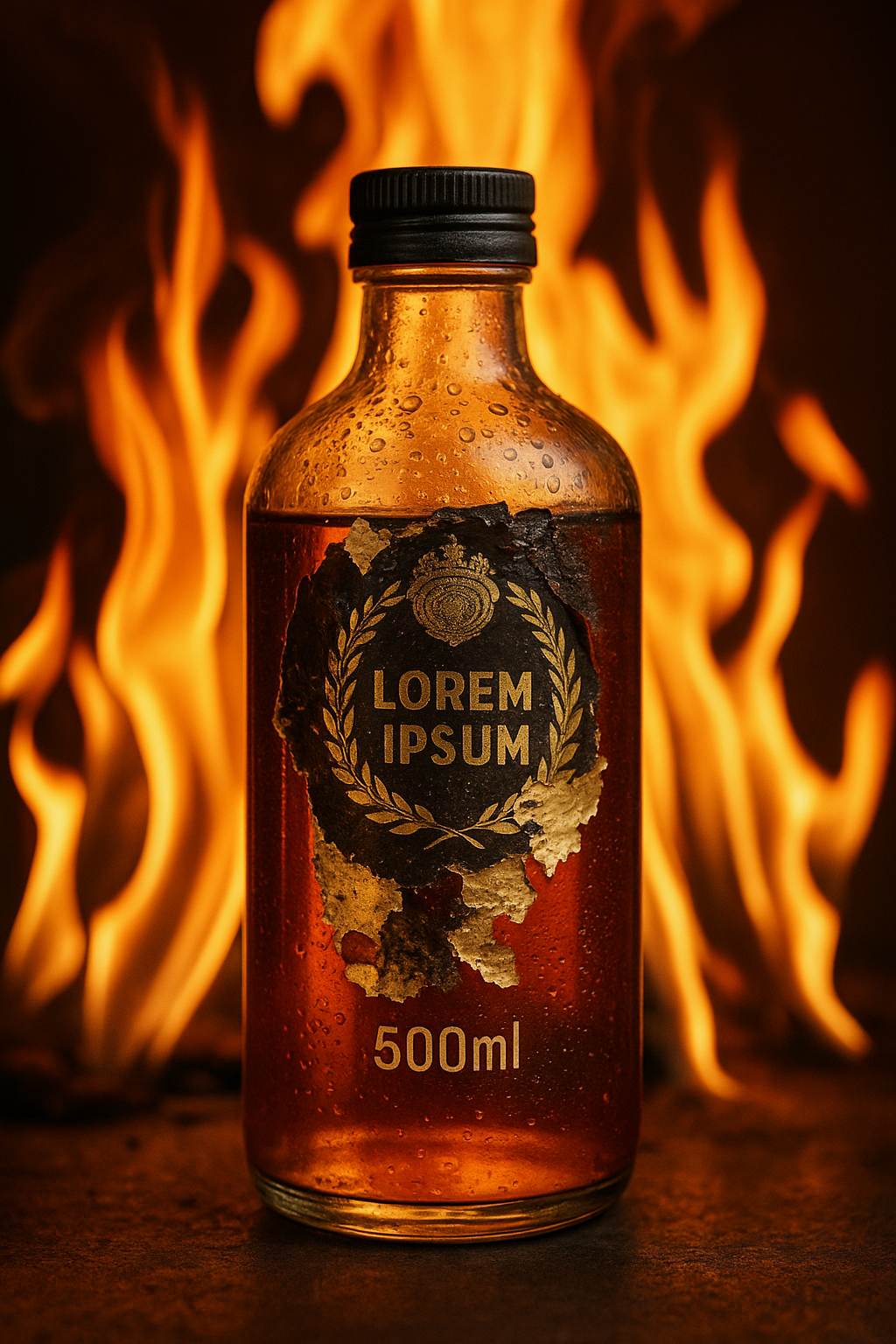
Heat Exposure
Heat is one of the most aggressive threats in the decorated glass bottle’s post-production journey. Whether it is from hot fill lines in juice and sauce production or summer heatwaves inside shipping containers, elevated temperatures wreak havoc on decorative materials.
Hot fill beverage lines expose decorated glass bottles to liquids at temperatures of 80 to 85°C. Summer cargo transport pushes interior container temperatures to 45 to 50°C in Indian summers.
Impact on Decoration:
• Heat-sensitive adhesives in foils begin to delaminate • Inks, especially organic, fade, smear, or discolor • Glossy or matte coatings soften and become tacky if not properly cured. This is not hypothetical. A 2024 study from the Indian Institute of Packaging found that one in five complaints related to packaging aesthetics stemmed from temperature-induced decoration failures during transit.
Cold and Condensation
Temperature drops are equally damaging. Products that travel through refrigerated supply chains or air cargo are routinely exposed to near-freezing temperatures.
Cold chain for dairy and pharmaceuticals subjects bottles to temperatures of 4°C or lower. Freezer displays in retail are especially common for health beverages.
Impact on Decoration:
• Ink contracts and may develop microcracks • Moisture condensation under labels or on coatings can cause lifting, peeling, or bubbling • Multiple cold-warm cycles accelerate the aging of low-grade decorative finishes
Repeated transitions between ambient and refrigerated environments are now routine in e-commerce and direct-to-consumer models. The need for freeze-thaw resistant materials has never been greater.
Humidity
In regions like Southeast Asia, humidity is not seasonal, it is year-round. Monsoon humidity in Indian coastal cities regularly exceeds 85 percent relative humidity, rising up to 92 percent in places like Navi Mumbai and Kochi.

Impact on Decoration:
• Water-based inks absorb moisture and bleed • Foil adhesives weaken and lose grip • Mold and microbial growth form on decorative paper labels or poorly sealed surfaces
A major herbal skincare brand in 2024 reported label failures across multiple states due to uncontrolled warehouse humidity. The root cause was that the decorative adhesives were not rated for high-relative humidity environments.
Manual Handling
Decorated glass bottles pass through many hands before reaching the end consumer. In restaurants, kitchens, bars, warehouses, and during fulfillment, each touchpoint introduces risk.
E-commerce pick and pack chains involve high-speed packing with minimal protection. The Horeca segment sees bottles washed, refilled, or handled by kitchen staff multiple times.
Impact on Decoration:
• Conveyor belts abrade uncoated prints • Foils and inks degrade from the friction of cardboard dividers or shrink wraps • Oils and moisture from human hands interact with untreated coatings

In 2024, a premium spice oil brand noticed frequent complaints from customers about partially erased labels within days of delivery. Investigation revealed the issue was not in the material but in friction damage during direct-to-consumer courier handling.
The takeaway is clear. Decoration is not just about initial appeal. It must be engineered to endure. Each environmental challenge is a real-world filter that exposes flaws not visible in the studio. In 2025, survival of the most decorative depends on how rigorously your packaging design anticipates these conditions.
The Testing Fallacy: When Lab Simulations Fail Reality
In theory, a packaging decoration that survives laboratory testing should hold up in the real world. But theory is not reality. Industry-standard tests like ASTM D4332 and ISTA protocols simulate only a narrow spectrum of conditions that may not accurately reflect the true environmental and logistical challenges that decorated glass bottles encounter, particularly in tropical regions like India.

Laboratory environments are controlled, consistent, and time-bound. In contrast, real-world conditions are chaotic, fluctuating, and sustained over days or weeks. For example, a bottle tested for humidity in a lab chamber for 48 hours might seem durable, but real-life distribution in coastal regions could expose it to 90%+ RH for weeks in storage before it even reaches the shelf.
Real-World Failure: Honey Jar Recall in Chennai
- Location: Non-climate-controlled warehouse in Chennai
- Temperature & Humidity: 34°C ambient temperature and 88% relative humidity
- Decoration Used: Gold foil label with a gloss coating
- Problem Observed: Within two weeks, the foil began to peel, and the gloss layer turned tacky
- The Catch: The product had passed ISTA tests including humidity and vibration protocols
- Conclusion: The decoration was not tested under prolonged high-humidity, high-temperature conditions that are typical in tropical monsoon zones. Hence, it failed in reality despite lab success.
This case highlights a dangerous assumption in packaging design that standardized test results automatically equate to in-market durability. Brands relying solely on generic tests often overlook the environmental nuances of the regions they operate in.
The Smarter Approach: Climate-Specific Simulation
To truly ensure the performance of decorated glass bottle techniques, brands must go beyond checklist testing. Here’s how:
- Tropical Conditioning Chambers: Simulate Indian coastal and tropical conditions for 10 to 30 days at 85–95% RH and 35–40°C. Ideal for testing foil adhesion, coating tackiness, and ink resistance.
- Humidity Exposure Validation: Validate how adhesives, inks, and coatings respond to moisture saturation and RH cycling.
- Temperature Cycling: Evaluate freeze-thaw endurance and cold storage transitions for bottles that may undergo refrigerated logistics.
- Geography-Specific Protocols: Align your testing parameters with the actual climate and shelf-life conditions of your product’s end market. For instance, what works in Berlin may fail in Goa.
The takeaway is powerful: never assume lab-tested equals market-ready. Your decoration strategy must be validated under the same environmental stress it will endure outside the lab- otherwise, you’re designing for fiction, not function.
Surface Prep: The Invisible Dealbreaker
In the decoration process of a glass bottle, everything begins with the surface. If the substrate isn’t properly prepared, even the most advanced decoration technologies will fail. Surface preparation is the foundation that determines whether your ink will adhere cleanly, whether your foil will last through transport, and whether your decoration will survive months of real-world handling.
In fact, poor surface preparation is the silent saboteur of decoration longevity. It doesn’t show itself during production, but once the bottle enters distribution, its consequences become painfully obvious.
What Contaminates a Glass Bottle’s Surface?
Even freshly manufactured bottles can be contaminated. The problem is not always visible to the naked eye. Here are some typical culprits:
- Mold-release agents: Lubricants used in the bottle-making process often leave an invisible oily residue.
- Dust accumulation: Bottles stored in open or semi-open environments before decoration can collect fine dust particles.
- Human touch: Fingerprints introduce oils, skin cells, and moisture onto the glass, impacting adhesion.
If not removed, these contaminants prevent proper bonding of decorative elements and lead to bubbling, smudging, or complete delamination.
Engineering the Right Surface Treatment
To counter these invisible threats, surface activation techniques are essential. Here are the leading processes used to prepare decorated glass bottles for high-performance decoration:
- Flame Treatment: This involves briefly passing the glass bottle through a controlled flame. The heat burns off organic contaminants and raises the surface energy, improving ink and adhesive anchoring.
- Corona Discharge: A high-voltage ionized air stream creates ozone and radicals that energize the glass surface, enhancing wettability and increasing the bonding ability of inks and coatings.
- Ionized Air Rinsing: A non-contact method where high-pressure ionized air dislodges dust and static-clinging particles from the bottle’s surface without introducing water spots.
- Deionized Water Washing: Unlike tap water, deionized water leaves no mineral residue. This method is highly effective for removing fine oils and salts, especially important for pharma and food-grade packaging.
When applied together or in sequence, these treatments ensure that the decorative layer sits on a chemically receptive and physically clean surface—drastically improving the life of any applied design.
“73% of decoration failures come from poor surface prep, not bad inks.”
– European Glass Packaging Study, 2023
This quote underscores the gravity of surface preparation. You can invest in the highest-grade foils, coatings, or ceramic inks- but if your substrate is unclean or untreated, the decoration will eventually fail. As decoration gets more sophisticated in 2025, overlooking the basics of surface prep can cost brands thousands in recalls, replacements, and lost reputation.
Environment-Based Decorated Glass Bottle Playbooks
No two environments are ever truly alike, and your decoration strategy should reflect that reality. What performs beautifully in Berlin’s cool, temperate climate can quickly deteriorate in the humid bustle of Mumbai or the scorching dryness of the Middle East. In 2025, packaging is no longer a one-size-fits-all endeavor. It demands adaptation, precision, and a deep understanding of the environments your product will encounter. Climatic conditions, warehouse infrastructure, and handling practices all shape the story of your decoration’s success or failure.
Let’s explore how decoration choices can be matched thoughtfully to different regional challenges.
Hot and Dry Regions (Delhi, Rajasthan, Middle East)
These are regions where the sun is relentless, the air is dry, and dust is part of daily logistics. Bottles in these areas may spend hours under direct sunlight on docks or in trucks, with no temperature control and plenty of abrasive exposure.

What works well:
UV gloss coatings act like armor against dust and sunlight, preserving both clarity and sheen. Ceramic inks, which bond chemically with the glass surface, are highly resistant to thermal shock and do not fade or flake. Hot foil stamping, especially when applied with durable adhesives, holds up under high temperatures without losing its brilliance.
What to avoid:
Water-based coatings and organic inks that are prone to cracking, fading, or lifting when exposed to high temperatures and dry air for prolonged periods.
Humid Coastal Regions (Mumbai, Kochi, Jakarta)
These are high-humidity zones where moisture saturates the air and easily seeps into unprotected surfaces. In many warehouses here, climate control is an afterthought, making it a real test for decorative resilience.

What works well:
Acid etching or sandblasting integrates the design into the glass surface itself, making it immune to peeling, bubbling, or smudging. Inorganic UV screen printing, cured under ultraviolet light, resists the microbial activity and ink bleeding that humidity tends to cause.
What to avoid:
Laminated paper labels that soak up moisture and curl at the edges. Decorative foils without protective overcoats, which can easily lift or blister in sticky air.
Cold Chain Applications (Dairy, Probiotics, Cold-pressed Juice)
These products depend on refrigeration throughout their lifecycle, from production to retail display. Decoration in this context must endure condensation, freezing, and repeated temperature cycling without degrading.

What works well:
Non-shrink UV coatings help maintain stability despite contractions from cold. Condensation-resistant films are essential for stopping labels from bubbling or slipping during temperature changes.
What to avoid:
Generic adhesives that break down when damp and inks that are not formulated to withstand thermal transitions, leading to cracking or discoloration.
Horeca and E-commerce Channels
From commercial kitchens to doorstep delivery, products here face constant physical interaction. They are touched, wiped, stacked, and repacked repeatedly. That kind of wear takes a toll on decorated glass bottles.

What works well:
Anti-scuff overcoats create a hard-wearing surface that protects prints and foils from friction damage. Laminated protective films act like invisible shields, absorbing daily wear without compromising design. Recessed decoration zones, where branding is placed in an indented surface of the bottle, minimize contact and preserve detail.
What to consider additionally:
Explore putting branding elements on tamper-evident sleeves or closures. These areas face less wear and may offer a more secure home for your logo or design elements.
What’s New in 2025? Emerging Glass Bottle Decoration Resilience Tech
In the ever-demanding world of packaging, brands are no longer asking, “Does it look good?” They are asking, “Will it still look good when it reaches the customer?” And rightly so. The real test of any decorated glass bottle is not just how it performs under studio lights. It is how it holds up under warehouse heat, humidity swings, and rough last-mile delivery.
In 2025, a new generation of decorated glass bottle technologies is stepping up. These are not just flashy additions. They are practical solutions to the kinds of wear and tear that brands see in real life. Here are some of the most meaningful advancements reshaping how we think about durability in decorated glass bottles.
Nano Laminate Overlays
This technology began as a cosmetic industry secret in South Korea, used on makeup bottles and jars that face high-touch environments. But it quickly earned a place in the toolkit of food and skincare exporters who needed packaging that could arrive intact. Nano laminates are paper-thin protective films that sit invisibly over decoration and guard it against scuffs, scratches, and smudges.
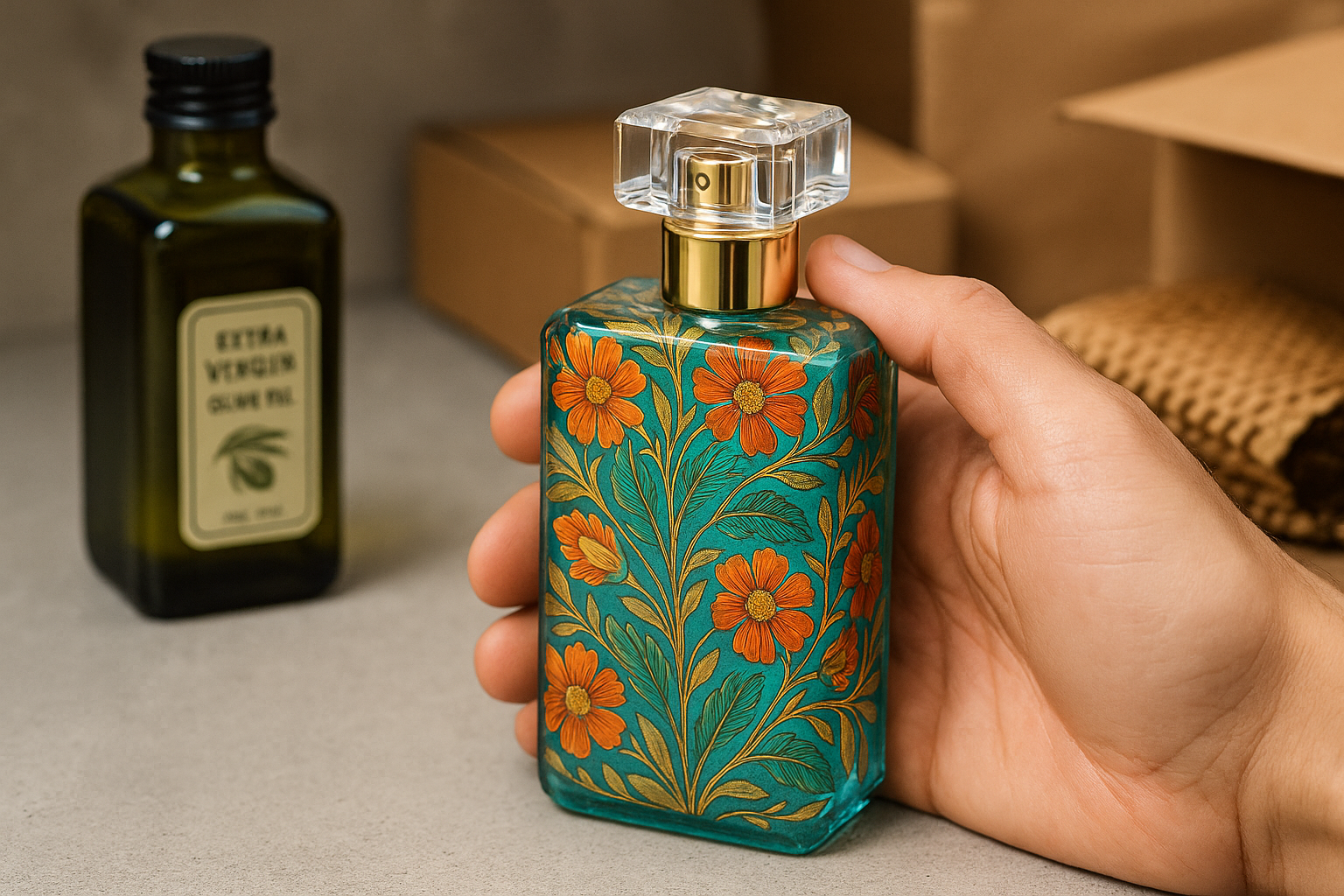
Think of them as armor that does not get in the way of beauty. When a gourmet oil jar reaches a customer after traveling halfway around the world, its label and print still look flawless. This is why more e-commerce brands and export-focused businesses are adopting nano laminate overlays as standard.
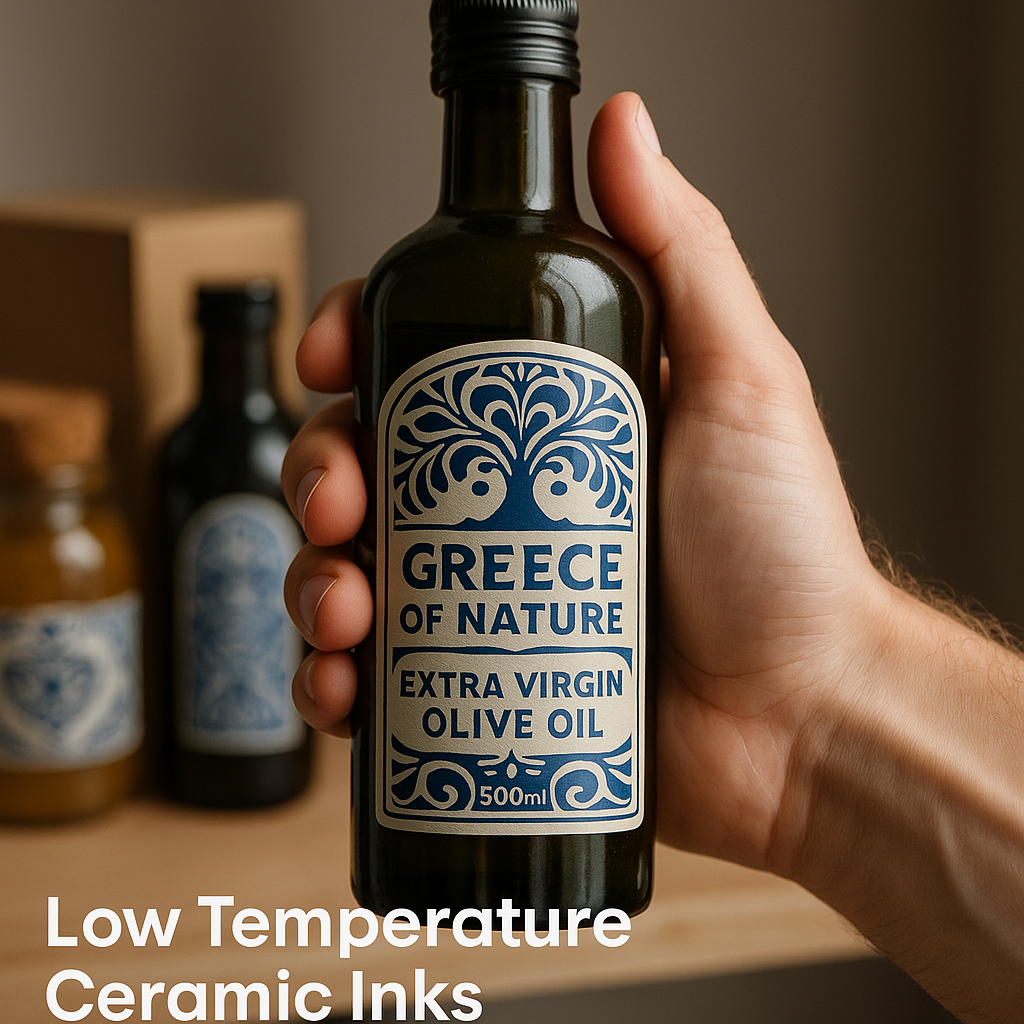
Low Temperature Ceramic Inks
Classic ceramic inks offered unbeatable durability but came with a catch. They needed to be cured at extremely high temperatures, making them energy-heavy and difficult to work with. Now, ceramic inks have evolved. The 2025 versions cure at lower heat and still deliver the same resilience.
European brands exporting olive oils, truffle spreads, and artisan condiments are already using this upgraded ink on their premium jars and bottles.
Smart Visual Indicators That Communicate Condition
Decoration today can do more than sit pretty. It can inform. It can respond. It can protect brand integrity by telling people when something has gone wrong.
Thermochromic inks are being used on probiotic and dairy bottles to indicate whether the cold chain has been broken. If the product warms beyond safe levels, the color changes. This lets the retailer or even the end user know that something may have gone wrong in transit.

Photochromic decoration is being used on beauty and wellness products that are sensitive to sunlight. These inks change when exposed to UV rays, warning that a product has been kept in the sun for too long. For brands that sell in tropical or high-exposure markets, this provides an additional layer of quality assurance.
These technologies are not gimmicks. They are building trust. They tell a customer, silently but clearly, that the brand they chose is thinking beyond the shelf and into their hands.
Because in 2025, a good decorated glass bottle is not just about being noticed. It is about being remembered for all the right reasons.
Ajanta Bottle’s In-House Advantage
At Ajanta Bottle, we understand that decoration is not just a design layer. It is a performance layer. Over the last 43 years, we have worked with hundreds of brands across the food, beverage, cosmetics, and wellness industries. And one insight is clear: durability is just as important as beauty.
That’s why we have built our own in-house glass bottle decoration unit, equipped with industry-leading technologies and region-specific testing protocols. Unlike outsourced systems that generalize decoration for mass production, our setup allows for control, precision, and customization—tailored to real-world environments, especially across Indian and tropical logistics conditions.
We offer: • Performance testing against tropical humidity, rough handling, and hot-fill stress • Decoration strategies customized for dry zones, cold chains, and coastal storage • Advanced surface preparation using flame and ionized air systems • Durable decoration formats like ceramic inks, acid etching, UV gloss finishes, and hot foiling • Strict batch-wise quality checks on decorated glass bottles designed for export-level compliance.
Every decorated glass bottle we create is designed with longevity in mind. Whether it’s a honey jar from Himachal or a probiotic vial heading to Singapore, we build packaging that stays as stunning in your customer’s hands as it was on your production line.
At Ajanta Bottle, decoration isn’t an afterthought. It’s a promise that your packaging will perform.
Ready to Redefine Your Packaging?
Connect with us:
● Email at sales@ajantabottle.com
● Phone/Whatsapp: +91 9891098918
You can also shop from more than 500+ packaging solutions on www.ajantabottle.com – India’s first ever comprehensive packaging e-commerce portal.
For additional information, browse through our blog at https://www.ajantabottle.com/blog/ or subscribe to our latest updates through our social media channels,
*YouTube channel: https://www.youtube.com/c/Ajantabottle
*LinkedIn Page: https://www.linkedin.com/company/ajantabottle
*Facebook Page: https://www.facebook.com/glassbottleindia
*Instagram Page: https://www.instagram.com/ajantabottle
*Google Business Profile Manager: https://g.page/r/CXTH9MKpe2DuEBM/review


